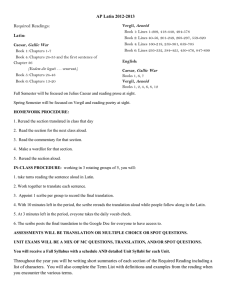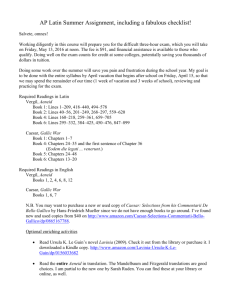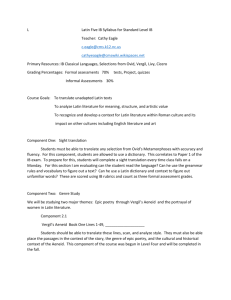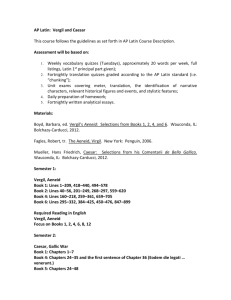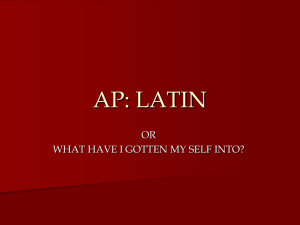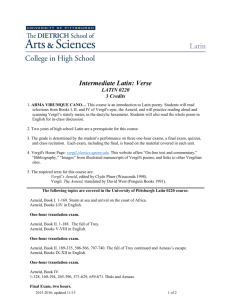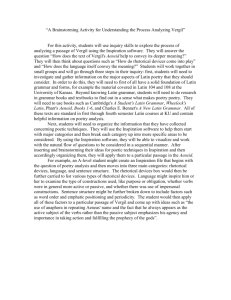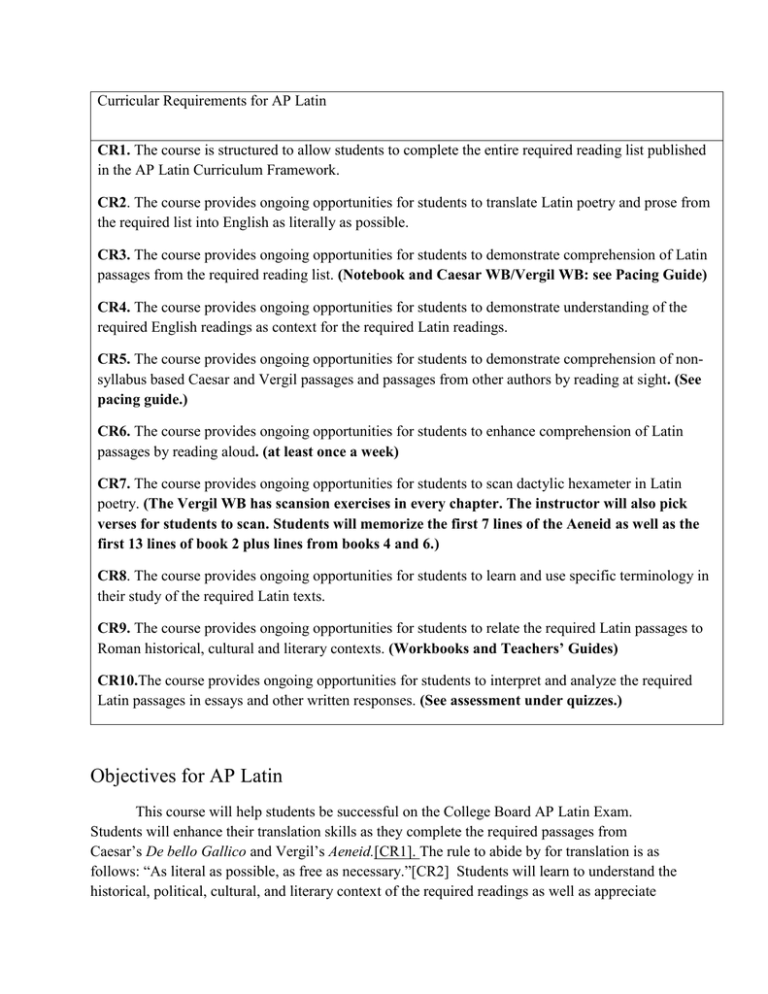
Curricular Requirements for AP Latin
CR1. The course is structured to allow students to complete the entire required reading list published
in the AP Latin Curriculum Framework.
CR2. The course provides ongoing opportunities for students to translate Latin poetry and prose from
the required list into English as literally as possible.
CR3. The course provides ongoing opportunities for students to demonstrate comprehension of Latin
passages from the required reading list. (Notebook and Caesar WB/Vergil WB: see Pacing Guide)
CR4. The course provides ongoing opportunities for students to demonstrate understanding of the
required English readings as context for the required Latin readings.
CR5. The course provides ongoing opportunities for students to demonstrate comprehension of nonsyllabus based Caesar and Vergil passages and passages from other authors by reading at sight. (See
pacing guide.)
CR6. The course provides ongoing opportunities for students to enhance comprehension of Latin
passages by reading aloud. (at least once a week)
CR7. The course provides ongoing opportunities for students to scan dactylic hexameter in Latin
poetry. (The Vergil WB has scansion exercises in every chapter. The instructor will also pick
verses for students to scan. Students will memorize the first 7 lines of the Aeneid as well as the
first 13 lines of book 2 plus lines from books 4 and 6.)
CR8. The course provides ongoing opportunities for students to learn and use specific terminology in
their study of the required Latin texts.
CR9. The course provides ongoing opportunities for students to relate the required Latin passages to
Roman historical, cultural and literary contexts. (Workbooks and Teachers’ Guides)
CR10.The course provides ongoing opportunities for students to interpret and analyze the required
Latin passages in essays and other written responses. (See assessment under quizzes.)
Objectives for AP Latin
This course will help students be successful on the College Board AP Latin Exam.
Students will enhance their translation skills as they complete the required passages from
Caesar’s De bello Gallico and Vergil’s Aeneid.[CR1]. The rule to abide by for translation is as
follows: “As literal as possible, as free as necessary.”[CR2] Students will learn to understand the
historical, political, cultural, and literary context of the required readings as well as appreciate
the style of writing and use of rhetorical and poetic devices of Caesar and Vergil.[CR8 &9]
Students will read aloud with comprehension and expression Latin prose and poetry.[CR6] All
students throughout the year will develop their ability to read at sight the required readings plus
those of other authors of prose and poetry.[CR5] Finally, students will learn how to scan dactylic
hexameter and recite with expression, fully recognizing the function and meaning of elisions,
hiatus, caesurae, and enjambment.[CR7]
Course Expectations for AP Latin
Over the summer students will read in modern translation the required readings in Latin
and English of De bello Gallico and the Aeneid. This task will help them understand these works
of literature and put them into their historical, cultural, and literary context.[CR9]
The instructor requires that students enter the classroom in a timely fashion and be ready
to start the day’s lesson when the bell rings. Students will have fully and carefully translated
their homework. When students encounter difficulty translating their lines at home, the instructor
expects that each line’s literal definitions be expressed accurately; later, semantics and idiomatic
rendering into English will be worked out in class.[CR2] Students will read aloud with
expression and discuss their translations with their classmates.[CR6] Students will have their
own notebook with their translations written below the texts of Caesar or Vergil. Students are
required to render literal translations of the following grammatical constructions: ablatives
absolute, independent (hortatory, jussive) and subordinate subjunctives, including fearing
clauses, purpose clauses, result clauses, indirect commands, indirect questions, cum
(circumstantial, causal, concessive) clauses; gerunds, gerundives, passive periphrastic, ad
purpose phrases, supines; deponent verbs, impersonal verbs; participles(present active, future
active, perfect passive); usages of all six indicative cases; conditional clauses.[CR2,CR3, CR8]
In addition to prepare literal translations, students will practice sight translations on a
regular basis in order to do well on the multiple choice questions based on sight reading passages
of authors different from Caesar and Vergil.[CR5] The multiple choice section is comprised of
the following seven types of questions: translation, comprehension, grammar, reference to a
specific person, place, or thing mentioned in the text, figures of speech, scansion, and
background.[CR7 & CR8] Because macrons are not provided, students must notice the
separation of nouns from their adjectives, strategic placement of words, and diction.[CR3] Soon
students will approach their daily translations as sight translations. They will learn to make
decisions concerning translation without as much reliance on the notes supplied in their texts.
Previous A P exams will enable students to become more proficient, critical thinkers.
The instructor will check students’ grasp of rhetorical and poetic devices on a daily basis.
Students will strive to learn alliteration, assonance, apostrophe, asyndeton, chiasmus, ecphrasis,
enjambment, hyperbaton, hyperbole, litotes, metaphor, metonymy, onomatopoeia,
personification, polysyndeton, rhetorical question, simile, synchesis, and tmesis. [CR8] Students
will define those terms on a test. Rhetorical and poetic devices will be emphasized in class
discussions and in student notebooks and journals. Finally, students will be expected to identify
these devices in Caesar and Vergil workbook exercises of the course syllabus passages. They
will also point them out in non-syllabus based passages of Caesar and Vergil as well passages
from other authors, such as Cicero, Pliny, Catullus, Martial, and Ovid.[CR5]
Students are also expected to keep a weekly journal with their own reflections about the
passages read and discussed during the week. Notebook entries should be written in a style that
reflects the type of interpretive and analytic essays that AP test graders want students to write on
the exam. Therefore, notebook essays must be grounded only on the text being discussed. In both
notebook essays and test essays, students should quote Latin lines or phrases to support their
analyses. These quotes should be accurately paraphrased or translated according to the accepted
style of citation on the AP exam. These quotes will come from the beginning, middle, and end of
the passages scrutinized.
Upon entry into AP Vergil, students will be tested on their general knowledge of the epic.
The instructor will impart Homeric heroic ideals so that students can understand Vergil’s
conception of the ideal Roman hero and Homer’s conception of the ideal Greek hero. Students
will memorize the first seven lines of the Iliad in Greek to see the first use of dactylic hexameter.
Students will be expected to know the role played by specific characters of the Aeneid.
Throughout the course, the teacher will bring in passages of the Iliad and the Odyssey to
facilitate students’ knowledge of the Odyssean (books 1-6) and the Iliadic books (7-12) of the
Aeneid.
Instructors will help students understand the Augustan Participate and its concomitant
architecture and literature and how they reflect a Roman sense of moral superiority and the right
to rule. Students will also learn how the art, architecture, and literature of the Augustan Age
helped the Emperor Augustus foster a sense of unity of empire after a century of constant civil
war in the Roman world, i.e., the Social Wars, the civil strife perpetuated by Marius, Sulla,
Caesar, Pompey, and, finally, Augustus’ defeat of Mark Antony. (C5- The course examines the
historical, social cultural and political context of Vergil’s Aeneid.) Of course, the instructor must
be totally familiar with the most current AP Latin course description. (C1- The teacher has read
the most current AP Latin Course Description.)
Assessment
Notebook with journal- 25%. Students have A Notebook for Caesar’s De Bello Gallico by
Stephen Daly Disinti for the first semester. Also, for the second semester students will use A
Notebook for Vergil’s Aeneid by the same author. The format of the Notebooks is as follows: the
left-side page has the text and vocabulary notes with room in between for interlinear translation.
Underneath the text the students will provide interlinear translation with English translated words
under the Latin text. The English words will reflect the verb tenses and noun and adjective cases.
The interlinear translation will employ these colors to reflect the grammar of the passage: for
vocative case – quotation marks; Nominative= Blue; Genitive= Green; Dative= Orange;
Accusative= Red; Ablative= Yellow. Adjectives will be pink with an arrow drawn to the noun
they modify. Adverbs will be brown with an arrow drawn to the verb, adverb or adjective that
they modify. Conjunctions will be Purple. Students will underline the main verb and twice
underline the infinitives. A box will signify participial phrases. Ablative absolutes will be
circled. Subjunctive subordinate clauses will be noted under the facing page of the notebook in
Additional Notes. Any other grammatical and syntactic concerns will be included under
Additional Notes. The facing page also has the literal translation of the passage from the leftside. Corrections to the translation line by line are made by the students with the peers and the
teacher. New vocabulary words will be listed for each passage.
Quizzes/sight translations 20% The Caesar workbook (WB) and the Vergil WB have exercises
that emphasize grammar and syntax, translation with chunking, analysis, and essay writing that
pertain to the passages translated by the students. These exercises are quiz grades. Sight
translations from passages not on the A P reading list for Caesar and Vergil as well as other
authors will be given to the students (see pacing guide) regularly. In addition, sight translations
from the A P reading list will be given once a week to each student. At times, students will work
with their partners to ensure that peer tutoring and peer learning are taking place during sight
translation exercises.
Daily Assessment - 15%. The teacher will grade daily lines, ensuring the grammatical structures
are rendered in accordance with AP guidelines. All rhetorical and poetic devices will be noted.
Students will read aloud with expression at least once a week the prose of Caesar’s Gallic War.
The instructor will teach the students how to scan dactylic hexameter first from Catullus 64, then
from the Aeneid and Ovid’s “Pyramus and Thisbe” from The Metamorphoses. Students must
demonstrate knowledge of scansion of dactylic hexameter, including elisions, caesurae,
enjambment, and the concept of form= meaning with regard to spondaic lines and predominately
dactylic ones. Students will scan dactylic hexameter lines on the Smartboard, and other students
will correct the mistakes. With practice they shall master this concept.
Tests- 30% Tests will consist of translation passages from the A P reading list, questions
concerning grammar, syntax, analysis, and essays relating a passage to its content and how it
relates to Roman historical, cultural, and literary contexts. Mueller’s Teacher’s Guide for Caesar
(2013) and Boyd’s Teacher’s Guide for Vergil (2006) as well as the instructor’s ideas have many
good essay topics which will be utilized.
1st Semester Exam - 10%. A complete AP Caesar Exam from a previous year will be
administered. The students will then understand fully how their upcoming AP Caesar test will be
graded. We will examine their weaknesses and make plans for improvement.
2nd Semester Exam- 10%. Earlier AP Vergil Exam will be administered at least a month before
the actual 2015 AP Vergil Exam. Problems and difficulties will be discussed and addressed in
order to make final preparations for the 2015 AP Latin Exam.
Required Readings in Latin
Caesar, Gallic War
Book 1: Chapters 1-7
Book 4: Chapters 24-35 and the first sentence of Chapter 36
(Eodem die legati … venerunt.)
Book 5: Chapters 24-48
Book 6: Chapters 13-20
Vergil, Aeneid
Book 1: Lines 1-209, 418-440,494-578
Book 2: Lines 40-56, 201-249, 268-297, 559-620
Book 4: Lines 160-218, 259-361, 659-705
Book 6: Lines 295-332, 384-425, 450-476, 847-899
Required Readings in English
Vergil, Aeneid
Books 1, 2, 4, 6, 8, 12
Caesar, Gallic War
Books 1, 6, 7
Readings in English in the Course
The required syllabus for the course includes not just readings in Latin but also readings
in English from Vergil’s Aeneid and Caesar’s Gallic War. The purpose of the English readings is
to put the Latin passages in context, with their significant themes, central characters, and key
ideas. The English readings also help students relate the passage studied in Latin to overarching
themes and essential questions proposed for the course.
AP Latin 2014-2015 Pacing Guide
Week 1 August 4-8, 2014
De bello Gallico in translation,
Books 1-7
Week 2 August 11-15
Translate De bello Gallico Book 1:
Chapters 1-3 Caesar WB; Chapter
1& 2 Bk 1.1, 1.2,3: grammar,
syntax, multiple choice, and essay
Read aloud book I: 3
Week 3 August 18-22
[ CR5 sight translation: De bello Gallico
bk.I.8]
Week 4 August 25-29
Read aloud I;7, lines 7-16
Test Book 1.1-7
Week 5 September 2-5
[CR5 sight translation:The Death Of
Pliny the Elder Lines 1-18]
Week 6 September 8-12
Read aloud Chapter 28
Translate De bello Gallico Book 1:
Chapters 4-5, Caesar WB, Ch. 3 Bk
1.4-5 grammar, syntax, multiple
choice, and essay
Translate De bello Gallico Book 1:
Chapters 6-7. Review Book 1.
Caesar WB Ch. 4 Bk 1.6-7 grammar,
syntax, multiple choice, and essay
Translate De bello Gallico Book 4:
Chapters 24-25: Caesar WB Ch. 5
Bk 4.24-25 grammar syntax,
multiple choice, and essay
Translate De bello Gallico Book 4:
Chapters 26-30: Caesar WB Chs. 67 Bk 4.26-30 grammar syntax,
multiple choice, and essay
Fall Break September 15-19
Reread English readings of The
Gallic Wars.
Week 8 September 22-26
Translate De bello Gallico Book 4:
Chapters 31-33: Caesar WB Ch. 8
[sight translation: Cicero’s 1st
Catilinarian Oration, lines 1-9]
Bk 4.31-33 grammar syntax,
multiple choice, and essay
Week 9 September 29-October 3
Translate De bello Gallico Book 4:
Chapters. 34-36.1 (Eodem die
legati… vererunt.): . Caesar WB Ch.
9 Bk 4. 34-36.1 grammar syntax,
multiple choice, and essay
Week 10 October 6-10
Review and take Unit Exam on
Gallic Wars, Books 1 and 4 and on
the English readings.
Week 11 October 13-17
Translate De bello Gallico Book 5:
Chapters 24-29 Caesar WB Ch’s.
10-12 Bk 5. 24-29 grammar syntax,
multiple choice, and essay.
Week 12 October 20-24
Translate De bello Gallico Book 5:
Chapters 30-34. Caesar WB Ch’s.
13-14 Bk 5. 30-34. grammar syntax,
multiple choice, and essay
[Sight translation: Tacitus Tumultus et
Rebellio lines 1-12]
Week 13 October 27-31
Translate De bello Gallico Book 5:
Chapters 36-41. Caesar WB Ch. 1517 Bk 5. 36-41grammar syntax,
multiple choice, and essay
Week 14 November 3-7
Translate De bello Gallico Book 5:
Chapters 42-48 Test on Book 5.
Caesar WB Ch. 18-20 Bk 5. 42-48
grammar syntax, multiple choice,
and essay
Week 15 November 10-14
Translate De bello Gallico Book 6:
Chapters 13,14. Caesar WB Ch. 21.
Bk 6. 13. grammar syntax, multiple
choice, and essay
Test on book 5, Tuesday, 11/11/2014
Week 16 November 17-21
Translate De bello Gallico Book 6:
Chapters 15-17. Caesar WB Ch.
[Sight Translation: Latin Vulgate, Acts
of the Apostles, Unrest at Ephesus by
Apostle Paul Lines 1-11]
22Bk 14-16 grammar syntax,
multiple choice, and essay
Thanksgiving Break Nov. 24-28
Start review for semester exam
Week 17 December 1-5
Translate De bello Gallico Book 6:
Chapters 17-20. Caesar WB Ch.
23,24 Bk6 17-20. grammar syntax,
multiple choice, and essay
Week 18 December 8-15
Gallic Wars, Books 1, 4,5,6
Translation(4 passages), 2 essays (1
comparison/contrast),25 questions
on grammar, syntax, and rhetorical
devices
Semester Exam
Holiday Break Dec. 22- Jan. 2
Catullus 64 and Medea will help
students understand the tragedy of
Dido in book four of the Aeneid.
Week 19 January 5-9
[Memorize Aeneid 1, 1-7 (Initiation into
Dactylic Hexameter)]
Read Catullus 64 in translation;
read a synopsis of Euripides’
“Medea”; then, reread entire Aeneid
in translation.
Translate Aeneid Book 1: 1-60.
Vergil WB Bk. I: 1-33
grammar/syntax; famous names;
essay- history of Rome; roles of fate
and gods
Week 20 January 12-16
Translation/grammar quiz, I: 1-120
Translate Aeneid Book 1: 61-120.
Vergil WB Bk.I: 34-80 translation;
essay on Juno’s character; scansion
Week 21 January 19-23: Essay on
simile, lines 148-153/ Sight
translation,Ovid,Metamorphoses,
Bk.IV:105-12 (Pyramus/Thisbe)
Translate Aeneid Book 1: 121-181.
Vergil WB Bk I: 132-179
grammar/syntax; scansion/ poetic
devices quiz
Week 22 January 26-30
Translation/grammar/scansion quiz,
Bk. I;121-209
Translate Aeneid Book 1: 182-209,
418-440. Vergil WB I: 180209,essay
on heroic/human facets of Aeneas
Week 23 February 2-6
Translation/grammar/syntax/scansion
test on book one
Translate Aeneid Book 1: 494-578
essay on comparison of Dido to
Diana(lines 498-504)
Week 24 February 9-13
Memorize & and recite with
expression and in meter book 2, lines
1-13 after sight translation of these
lines.
Translate Aeneid Book 2: 40-56,
201-249. Discuss background
information on Book 2. Vergil WB
essay-Compare I: 148-56 with II:
40-56.
Winter Break February 16-20
Read all of book 2 in English and
practice scansion of verses selected
by the instructor.
Week 25 February 23-27
Translate Aeneid Book 2: 268-297Vergil WB, essay on Hector’s ghost,
559-589- translation/scansion
Week 26 March 2-6
Translation/scansion/essay test: Bk 2
Translate Aeneid Book 2: 590-620
Vergil WB-grammar/syntax/poetic
devices
Week 27 March 9-13 Discuss
background information on book 4.
(Catullus 64 and Euripides’ Medea)
Translate Aeneid Book 4: 160-218.
Read in English lines 1-159.Vergil
WB grammar/syntax/scansion
Week 28 March 16-20
sight translation: Catullus 64:52-60
Discussion of historical context and
vocabulary- Horace’s Cleopatra Ode
Translate Aeneid Book 4: 259-309
Vergil WB grammar/syntax, poetic
devices, scansion
Week 29 March 23-27 essay quiz:
Dido and Aeneas’ confrontation
Translate Aeneid Book 4: 310-361
Vergil WB grammar/syntax,
Spring Break March 30- April 3
Translate Aeneid Book 4: 659-705
Week 30 April 6-10
Translation/grammar/scansion/
poetic devices/essay test on bk. 4
Week 31 April 13-17 Discuss
background information on bk.4
Compare with Odysseus’ descent into
the Underworld (essay).
Translate Aeneid Book 6: 295-332,
384-404. Read in English Bk. 6: 1294. Discuss Vergil’s narrative
technique.
Week 32 April 20-24
Quiz on poetic/rhetorical devices
Translate Aeneid Book 6: 405-425,
450-476 Vergil WB
grammar/syntax/poetic devices,
scansion
Week 33 April 27- May 1
Translation, grammar, scansion,
essay test on book 6.
Translate Aeneid Book 6: 847899Vergil WB grammar/syntax,
poetic devices, scansion exercises
Week 34 May 4-8
Review De bello Gallico, books
1,4,5,6,7.
Week 35 May 11-15
Review Aeneid Books 1, 2, 4, 6, 8,
12.
Week 36 May 18-20
Caesar, De bello Gallico
A P Examination
Vergil, Aeneid
List of Resources
1. Hammond, Carolyn. Caesar. The Gallic War: Seven Commentaries on The Gallic War
with an Eighth Commentary by Aulus Hirtius. Oxford World’s Classics, 2008.
2. Meuller, Hans-Friedrich. Caesar: Selections from De Bello Gallico. Bolchazy-Carducci
Publishers, 2012.
3. Williams, Rose and Nousek, Debra L. A Caesar Workbook. Bochazy-Carducci
Publishers, 2012.
4. Finch, James B. Caesar Completely Parsed: Caesar’s Gallic War Book 1. BochazyCarducci Publishers, 2012.
5. Frerichs, Karl. Cicero’s First Catilinarian Oration.Bolchazy-Carducci Publishers, 2004.
6. Goldsworthy, Adrian. Caesar: Life of a Colossus. Yale University Press (New
Haven/London, 2006).
7. D’Ooge, Benjamin L. Caesar in Gaul. Ginn and Company (New York) 1917.
8. Distini, Stephen. A Notebook for Caesar’s De Bello Gallico, Bolchazy-Carducci
Publishers, 2014
9. Mandelbaum, Allen, tr. The Aeneid of Virgil. University of California, 2007.
10. Boyd, Barbara Weiden. Aeneid: Selected Readings from Books 1, 2, 4 and 6. BolchazyCarducci Publishers, 2012. (main text)
11. Bradley, Katherine, and Boyd, Barbara Weiden. A Vergil Workbook. Bolchazy-Carducci
Publishers, 2nd ed., 2012.
12. Arnold, Bruce, Larson, Andrew, Lawall, Gilbert. Love and Betrayal: A Catullus Reader.
Prentice Hall, 2000
13. Garrison, Daniel. The Student’s Catullus. University Oklahoma Press: Norman and
London, 1989
14. Quinn, Kenneth. Catullus The Poems. St. Martin’s Press, 1973
15. Edwards, H.J. Caesar The Gallic War. Harvard University Press Cambridge,
Massachusetts London, England. 2004
16. Detter, Helena, Osburn, LeaAnn. Latin for the New Millennium III. Bolchazy-Carducci
Publishers, 2nd ed., 2012.
17. Russell, D.A. An Anthology of Latin Prose. Clarendon Press, New York, 1990
18. Carter, Ashley, Parr, Phillip. Cambridge Latin Anthology. Cambridge University Press.
New York, New York. 1996
19. Distini, Stephen. A Notebook for Vergil’s Aeneid , Bolchazy-Carducci Publishers, 2014
20. Hill, D.E., Ovid Metamorphoses I-IV Bolchazy-Carducci Publishers. 1987
21. Virgil: The Aeneid. Translated by Robert Fagles. New York: The Penguin Group, 2006.
22. Johnson, W.R. Darkness Visible: A Study of Vergil’s Aeneid. Berkely: University of
California Press, 1976.
23. LaFleur, Richard & McKay, Alexander. A Song of War: Readings from Vergil’s Aeneid;
Pearson Prentice Hall, 2004. (alternate textbook)
24. Perkell, Christine, Ed. Reading Vergil’s Aeneid: An Interpretive Guide. Norman:
University of Oklahoma Press, 1999.
25. Page, T.E., The Aeneid of Vergil books I-VI, VII-XII. New York St. Martin’s Press 1967
26. Quinn, Kenneth. Vergil’s Aeneid: A Critical Description. Ann Arbor: The University of
Michigan Press, 1968.
27. Williams, R.D. Vergil: Aeneid I-VI. Newburyport, MA: Focus, 2004.(alternate
text)Williams, R.D. Vergil: Aeneid VII-XII. Newburyport, MA Focus, 1997.
28. Everitt, Anthony. The Life of Rome’s First Emperor Augustus. Random House Inc. New
York. 2006.

